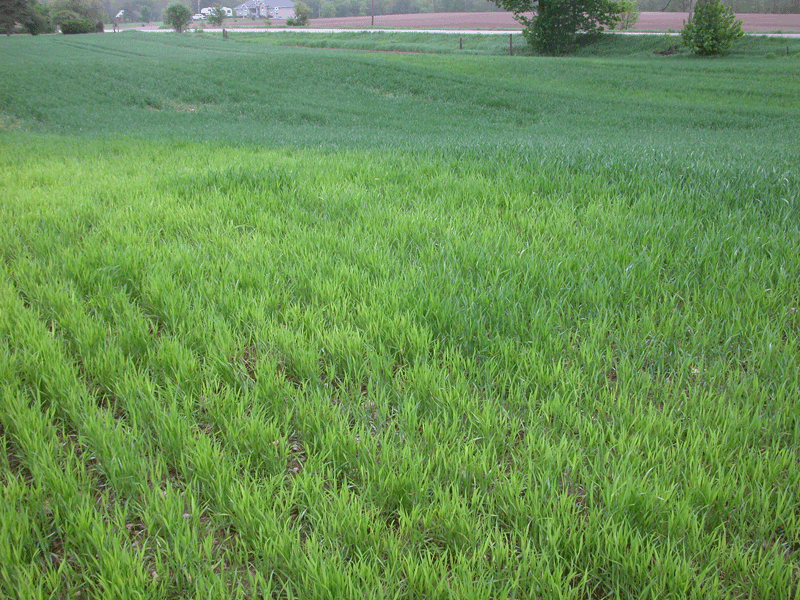Ontario sulphur trials
VARYING RESULTS
THERE IS GREAT debate as to whether or not producers should add sulphur in the form of sulphate to their soils, and if so, how much. Unfortunately, there is no clear-cut answer. The need for sulphur (known as sulphate in its oxidized form) will heavily depend on location, soil organic matter, and soil type, as well as the type of crop you are growing.

Sulphur is an essential nutrient for plant growth and fending off diseases, but it can only be used in its oxidized form, sulphate (SO42). While there can be large amounts of sulphur present in soil in its elemental form, it is not always available to crops. Soil bacteria and oxidation reactions convert sulphur to sulphate, a process that also involves mineralization, immobilization, and reduction.
HOW DO I KNOW IF MY SOIL IS SULPHUR DEFICIENT?
Some crops demand more sulphate than others. Corn, soybeans, wheat, alfalfa, and canola, for example, all require high amounts of sulphate for optimum growth. Vegetable crops, like lettuce, cucumbers, and melons, require very little sulphur. Sulphur deficiencies cause plants to appear pale green in colour. Whereas a nitrogen deficiency will appear in the lower part of the plant, a sulphur deficiency will change the colour of the entire plant.
According to a report by Certified Crop Advisor Dale Cowan, the average uptake of sulphate by most crops is in the 10 to 30 pound per acre range. “The average deposition of sulphur from air pollution is thought to be in the 20 to 25 pound per acre range,” he says. But is that enough? According to Environment Canada, sulphur falling in the form of acid rain has been steadily dropping since 1970, thanks to Canada’s Acid Rain Strategy. While this has been good news for the environment, the over 50 percent decrease between 1990 and 2010 has led to sulphur deficiencies in some fields.
To determine whether or not you have a sulphur deficiency, take a soil sample. This is especially important if you have low soil organic matter, sandy soils or you live in northwestern Ontario. Research shows that the deeper the sample is taken, the more accurate it will be. In Cowan’s studies, six samples revealed a possible need for sulphate when samples were taken at the zero to six inch depth. When deeper samples of zero to 12 inches were taken, that number dropped to two possible sites in need.
“Perhaps the deeper sampling profile is a better sampling depth to predict the need for sulphur in southwestern Ontario,” says Cowan.
What may appear to be a sulphur deficiency could very well be a result of the cooler growing conditions found in early spring, too. “As the soil and air temperature warms up, the conversion speeds up and root growth increases to take advantage of sulphate in the lower part of the root zone,” says Cowan.
“It also matters when you take the sample,” says Bonnie Ball, Ontario Ministry of Agriculture and Food (OMAF) Soil Fertility Specialist.“If you take it in the heat of summer versus late in the fall when it’s cold, it makes a difference to what the number’s going to be.”
When soil sampling for sulphur, if the sample is wet, Ball recommends air-drying it, especially if it is not going to get to the lab for a while.
FIELD TRIALS
OMAF researchers have recently looked at sulphur deficiencies in southwestern Ontario. Through field trials, they have been able to determine whether or not some crops will yield higher when sulphur is applied in the form of sulphate.
Peter Johnson, OMAF Wheat Specialist, conducted three years of wheat trials testing for yield response to sulphur. The trials began in 2011; Johnson recalls that spring was a particularly wet one. In fact, he says that it was the first time in his career that he saw significant sulphur deficiencies in wheat fields. “We got a 5.5 bushel per acre yield response, on average,” he says.
In 2012, yields increased by 2.3 bushels per acre on average, but only 13 of the 29 sites actually responded. “Our responsive sites showed a good yield increase, but over 50 percent of the time we got zero yield increase.”
Johnson attributes the different numbers to spring temperatures. “In 2013, a more normal spring – a little wetter than normal, a little cooler than normal – but not nearly as bad as 2011,” he says.“And lo and behold, on average, we only get a 1.3 bushel per acre yield increase in sulphur. But in our responsive sites, we’re still running in that three bushel per acre average yield. And we got a response in eight out of 13 locations, so it was basically close to two- thirds of the time that we got a response.”
“I really think that at some point we’re going to have to add sulphur on a more frequent basis or all the time because we’ve taken it out of acid rain or dry deposition,” he says.
“If you do have a sulphur deficiency that develops, 10 pounds per acre of sulphur as sulphate will correct the deficiency,” Johnson continues. “There are no guarantees. It’s not a slam dunk, but it is cheap insurance.”
Johnson also recommends doing strip trials on your fields. If you do not see a response in a bad year, then you will not need to apply sulphate in that field.
Greg Stewart, Corn Specialist with OMAF, ran trials that focused on the role of sulphur and zinc in corn. “In zero of our trials in 2012 did we see any response,” says Stewart. “We re-ran those trials again in 2013, looking at a range of starter fertilizer options, but specifically trying to put sulphur and zinc in. And I think we had one site out of 10 where we got a statistically significant response to the sulphur.”
“We don’t really argue with the idea that sulphur deposition is down,” he continues. “We don’t argue with the fact that some people report positive responses to sulphur. Just, whenever I try to go out and find it — and we did it about 10 years ago, as well — it’s just, for us, really inconsistent in terms of trying to find a significant number of sites that have an economical or statistical response to sulphur.”
Since positive results were lacking, Stewart decided not to conduct further trials this year. “We’ll come back and visit it again,” he says.“We’re not naysayers in the sense that there isn’t some reason to be thinking about it. And certainly there are areas where it does seem to mean something, but on average, I think my warning is try a bit of sulphur but just be careful that you’re not missing other opportunities to get a better return on your fertilizer dollar.” •

















